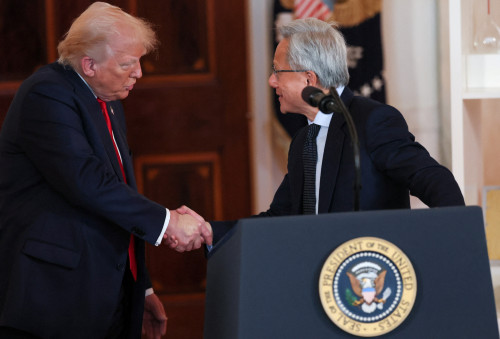By Saqib Iqbal Ahmed
NEW YORK (Reuters) – U.S. stocks are at fresh records, bitcoin is soaring and investors are spurning insurance against portfolio declines as evidence that the economy is headed for a so-called soft landing whets market participants’ appetite for risk.
Call it the Goldilocks trade – a bet that the Federal Reserve will be able to tame inflation while keeping growth from declining too rapidly. While that outcome was in doubt as recently as last month, investors have been reassured by a more recent spate of economic data – including Wednesday’s report showing U.S. consumer prices slowed more than expected in April.
Investors’ newfound renewed penchant for risk-taking can be seen across asset classes. The S&P 500 hit a new record high on Wednesday and is up 11% year-to-date as it rebounds from last month’s decline. The Nasdaq Composite Index and Dow Jones Industrial Average scaled fresh heights as well.
Assets such as bitcoin and meme stocks, which are often seen as barometers of risk appetite though their ties to economic fundamentals are often questioned, have also soared.
Meanwhile, participants’ growing confidence was reflected in a survey of fund managers by BofA Global Research: the firm’s broadest measure of investor sentiment, based on cash levels, equity allocations and economic growth expectations, stood at its most bullish since November 2021.
“Investors’ appetite for risk assets appears to be on the rise,” said Garrett DeSimone, head quant at OptionMetrics.
Here’s a chart-based look at how investors’ new found optimism is reverberating throughout markets:
After worries over the Federal Reserve’s ability to cut interest rates in the face of stubborn inflation prompted a 4.2% pullback for the S&P 500 index in April, investors now appear eager to ride stocks higher.
Many are opting to do so with little attention to hedging their downside. The Cboe Volatility index, which measures demand for protection from market swings, closed at a four-month low on Wednesday. The lesser-known VVIX index, a gauge of how much investors expect the VIX to move, has also dipped and now stands near its lowest level in about a decade.
While there are few takers for options hedges that would guard against a drop in the market, call contracts that would benefit from further stock market gains are in high demand.
The one month average daily trading in calls outnumber puts 1.2-to-1, the most bullish this measure has been in about a month, according to data from Options analytics firm Trade Alert.
Some market participants have also pointed to the rally in meme stocks as a sign of investors’ robust risk appetite.
Shares of GameStop have soared 140% over the last week, after a string of posts on the X platform from an account linked to Keith Gill, the central figure behind the previous frenzy. Shares of other companies, including theater chain AMC and headphones maker Koss have followed suit. Like GameStop, many of the stocks are heavily shorted and their fundamentals have declined over the last few years.
Hopes that softening U.S. economic data may give the Fed the leeway to cut rates later this year has pressured the dollar in recent sessions. The greenback, a popular haven during uncertain times, has dipped 2% against a basket of its peers since hitting a 17-month high in mid-April.
That has helped boost some emerging market currencies, which are sometimes considered riskier than those tied to developed markets.
The Polish zloty is up 3.7% for the month while the South African rand and the Colombian peso have advanced 2.8% and 2.7%, respectively.
Bond market volatility expectations have also slipped in recent sessions. U.S. Treasury yields – which move inversely to bond prices – fell to more than five-week lows on Wednesday.
Bitcoin, often viewed as a key barometer of risk-taking sentiment, hit a 3-week high of $66,261 on Tuesday and is creeping closer to the record high of $73,803 touched in March.
(Reporting by Saqib Iqbal Ahmed; Additional reporting by Lewis Krauskopf; Editing by Ira Iosebashvili and Shri Navaratnam)





